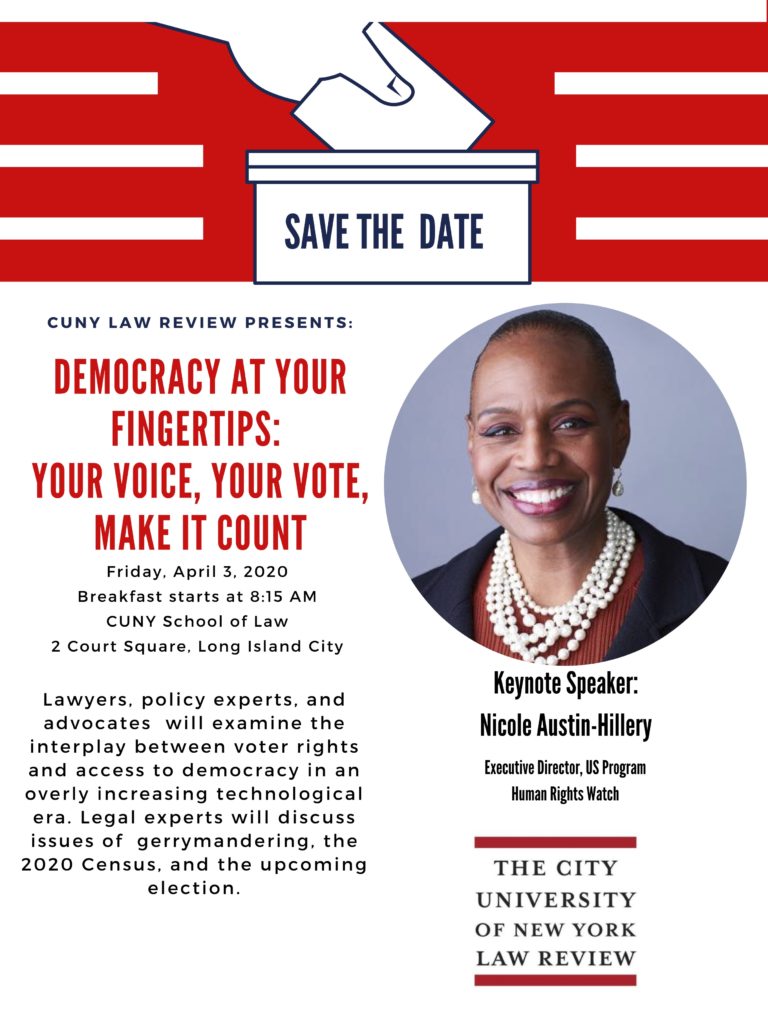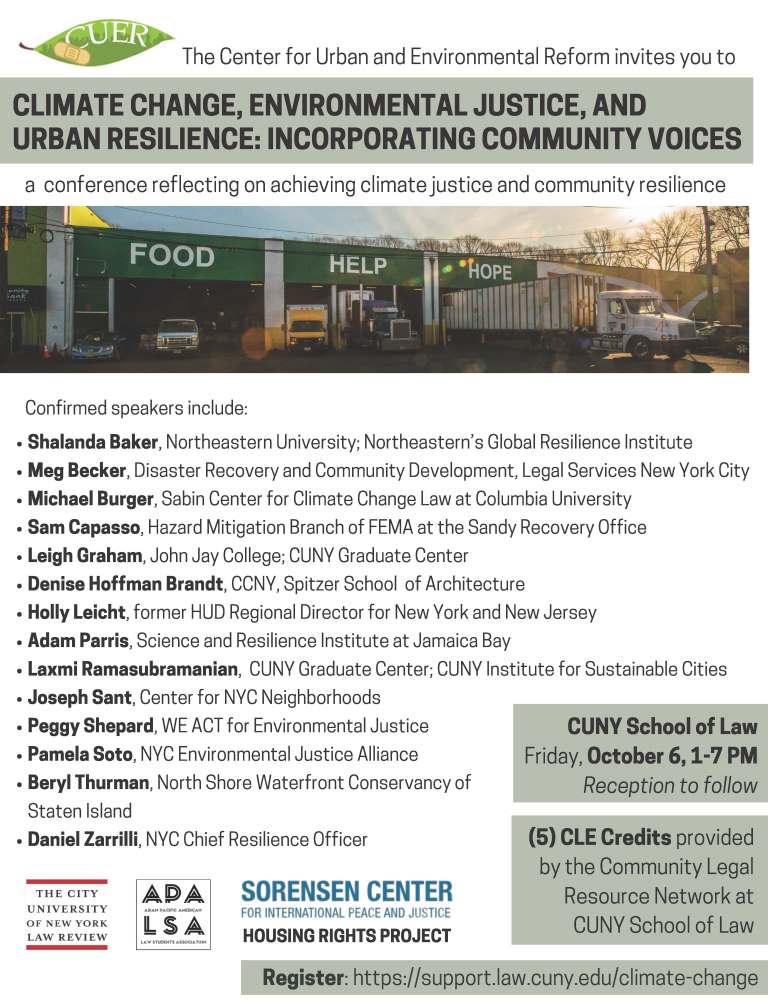The CUNY Law Review is proud to present our Spring 2020 Symposium, Democracy at Your Fingertips: Your Voice, Your Vote, Make It Count. The Symposium will take place on April 3, 2020.


The CUNY Law Review is proud to present our Spring 2020 Symposium, Democracy at Your Fingertips: Your Voice, Your Vote, Make It Count. The Symposium will take place on April 3, 2020.

We are excited to publish Volume 22.2. See below for specific articles or explore the complete digital version here.
Stewarding the City as Commons: Parks Conservancies and Community Land Trusts by John Krinsky, Professor of Political Science at the City College of New York and the City University of New York (CUNY) Graduate Center, and Paula Z. Segal, Senior Staff Attorney in the Equitable Neighborhoods unit at TakeRoot Justice.
Still Separate, Still Unequal: Litigation as a Tool to Address New York City’s Segregated Public Schools by Andrea Alajbegović, Law Graduate at Legal Services NYC and CUNY School of Law Class of 2019.
Limited Access Letters: How New York City Schools Illegally Ban “Unruly” Parents of Color and Parents of Students with Disabilities by Andrew Gerst, Staff Attorney/Sinsheimer Fellow, Mobilization for Justice, Warren J. Sinsheimer Children’s Rights Program.
Accidents Happen: Exposing Fallacies in Child Protection Abuse Cases and Reuniting Families Through Aggressive Litigation by Jessica Horan-Block, Supervising Attorney and Serious Abuse Case Coordinator at The Bronx Defenders Family Defense Practice, and Elizabeth Tuttle Newman, Staff Attorney at The Bronx Defenders Family Defense Practice.
Alejo Rodriguez†
Click here for a recommended citation and to download a paginated PDF version of this article.
Introduction: An Odyssey and an Awakening
In 1985 I was convicted for a robbery related homicide. I wish I could say that it wasn’t me, that they picked the wrong person out of the line-up, or that I had nothing to do with the actual shooting, but I can’t. The minute I picked up a gun with the thought that a robbery would somehow rid me of my drug dependent lifestyle was the minute I became the coward who would end up taking someone’s life. I received an eighteen years to life sentence and before I knew it, I was in Attica Correctional Facility. I was a twenty-three-year-old unskilled high school graduate who had never been incarcerated. I didn’t know how I would make it to see the next day, let alone the next eighteen years. All I had was the present, “one day at a time.”
Prison is a world in and of itself. It is designed to break the human spirit. Yet, strangely, there was a familiarity about prison that I didn’t expect. Sure, the constant threat of cell bars, prison guards, and gun towers were all new and intimidating, but the sense that there was no way out and the constant threat of violence were, in many respects, no different than where I grew up in the Bronx. Many of us came from the same neighborhoods, same families, and formed the same gangs. Drugs were readily available, as was gambling, and prostitution. It would be years before I would hear the term “school-to-prison pipeline,” but once I did, I knew for certain that it was more than just a catch phrase—we were its by-product. Continue reading
Hello from the 2019-2020 CUNY Law Review Editorial Board! If you’re reading this, you’ve found our website. We’re currently in the process of relaunching and repopulating this independently-run site with previous years’ content. In the future, you can expect to see Footnote Forum pieces, news about our upcoming events, and other timely updates.
Please don’t hesitate to reach out if you have any questions, and thank you for supporting scholarship for social justice.
Lee Clark†
Click here for a recommended citation and to download a paginated PDF version of this article.
As a trans person, one of the places that I have found safety is through the way I represent my gender expression. Clothing is at the pinnacle of my gender expression; it is something that I have had control over for a long time. To quote the famous social theorist Simone De Beauvoir, “One is not born, but rather becomes, a woman.”1 I might have been assigned female at birth, but I definitely did not express my gender in feminine ways, opting for clothes from the boys’ section of stores rather than the girls’ section. One way that people have been classified in society for centuries is through the lens of the gender binary as showcased through clothing, media, and culture. Clothing and fashion are where I recognized my personal autonomy at a young age, and how I could fight back against gender restrictions throughout my life.
A quote from Daniel Friedman, a suit designer from Brooklyn-based tailoring company Bindle & Keep, who works almost exclusively with trans and non-binary2 clients, resonated with me: “It’s all about feeling great in your body, especially when people have been struggling their entire lives and they finally get into something that really fits them . . . the way they’ve always envisioned something would fit them. That’s not fashion anymore and that’s what we’re after.”3 Obviously, clothing is fashion, as it pertains to garments and construction, but it extends further than that. Bindle & Keep is dedicated to dressing an identity and a body. Clothing and gender have a direct correlation as one of the ways to present one’s gender daily. Cis and trans people alike curate outfits and silhouettes that are used to present gender. But while the trans community is fighting for our fit in the courts, we are also fighting the gender binary that has never recognized our identity. Continue reading
We are excited to publish Volume 20.2. See below for specific articles or explore the complete digital version here.
Collaborating Across the Walls: A Community Approach to Parole Justice by Michelle Lewin, Co-Founder and Coordinator at the Parole Preparation Project, and Nora Carroll, Co-Founder of the Parole Preparation Project and staff attorney at The Legal Aid Society.
Reclaiming Restorative Justice: An Alternate Paradigm for Justice by Shailly Agnihotri, founder and Executive Director of the The Restorative Center, and Cassie Veach, recent graduate of CUNY School of Law.
Community Law Clinics in the Neoliberal City by John Whitlow, Assistant Professor of Law at University of New Mexico School of Law.
Paradoxes of Sovereignty and Citizenship by Hawa K. Allan, Fellow at the Center for the Study of Law and Culture at Columbia Law School.
9/11 and 11/9: The Law, Lives and Lies That Bind by Khaled A. Beydoun, Associate Professor of Law at University of Detroit Mercy School of Law.
In the Shadow of Gaslight: Reflections on Identity, Diversity, and the Distribution of Power in the Academy by Cyra Akila Choudhury, Professor of Law at Florida International University College of Law.
Hopeless Case?: Escaping the Proof Pitfall in Power-Dependent Paradigms by e. christi cunningham, Professor and Director of Education Rights Center at Howard University School of Law.
Normalizing Domination by Atiba R. Ellis, Professor of Law at West Virginia University.
On Race and Persuasion by Janine Young Kim, Professor of Law at Chapman University Fowler School of Law.
The Great American Dilemma: Law and the Intransigence of Racism by Erika Wilson, Assistant Professor of Law at the University of North Carolina at Chapel Hill School of Law.
Police Brutality, the Law & Today’s Social Justice Movement: How the Lack of Police Accountability Has Fueled #Hashtag Activism by Corinthia A. Carter, recent graduate of CUNY School of Law.
Silent Struggle: Constitutional Violations Against the Hearing Impaired in New York State Prisons by Farina Mendelson, Law Clerk at Muldoon, Getz & Reston.
Local Responses to Today’s Housing Crisis: Permanently Affordable Housing Models by Julie Gilgoff, Legal Fellow at Sustainable Economies Law Center.
This Friday, Oct. 6, we will be co-sponsoring a climate change conference at the school. Please join us as we listen to a host of incredible speakers on the issues of climate justice and community resilience. RSVP here: https://support.law.cuny.edu/climate-change.

Please join us next Tuesday, September 19th, when we discuss Public Corruption and the Rule of Law. Preet Bharara will be in conversation with moderation by Brian Lehrer. Other guests include Zephyr Teachout, Julie Sorenson, and David Hoffman. The event is being cosponsored with Sorenson Center.
RSVP here.

Please join us Tuesday, September 12, 5:00 p.m., at CUNY School of Law as we co-sponsor a conversation with Mary Bassett, who is commissioner of the New York City Department of Health and Mental Hygiene. Bassett will discuss her incredible work, which centers on racism as a leading public health threat.
RSVP here.

On behalf of the 2017–2018 CUNY Law Review Board, we are pleased to announce this year’s CUNY Law Review fall staff members! Please join us in congratulating our senior staff, returning staff, and incoming staff! We could not be more excited and inspired to work with this amazing group of students.
Senior Staff:
Melissa Britton
Abigail Downs
Alanna Doherty
Erica Taylor
Michael Perez
Christina Rosalin Peña